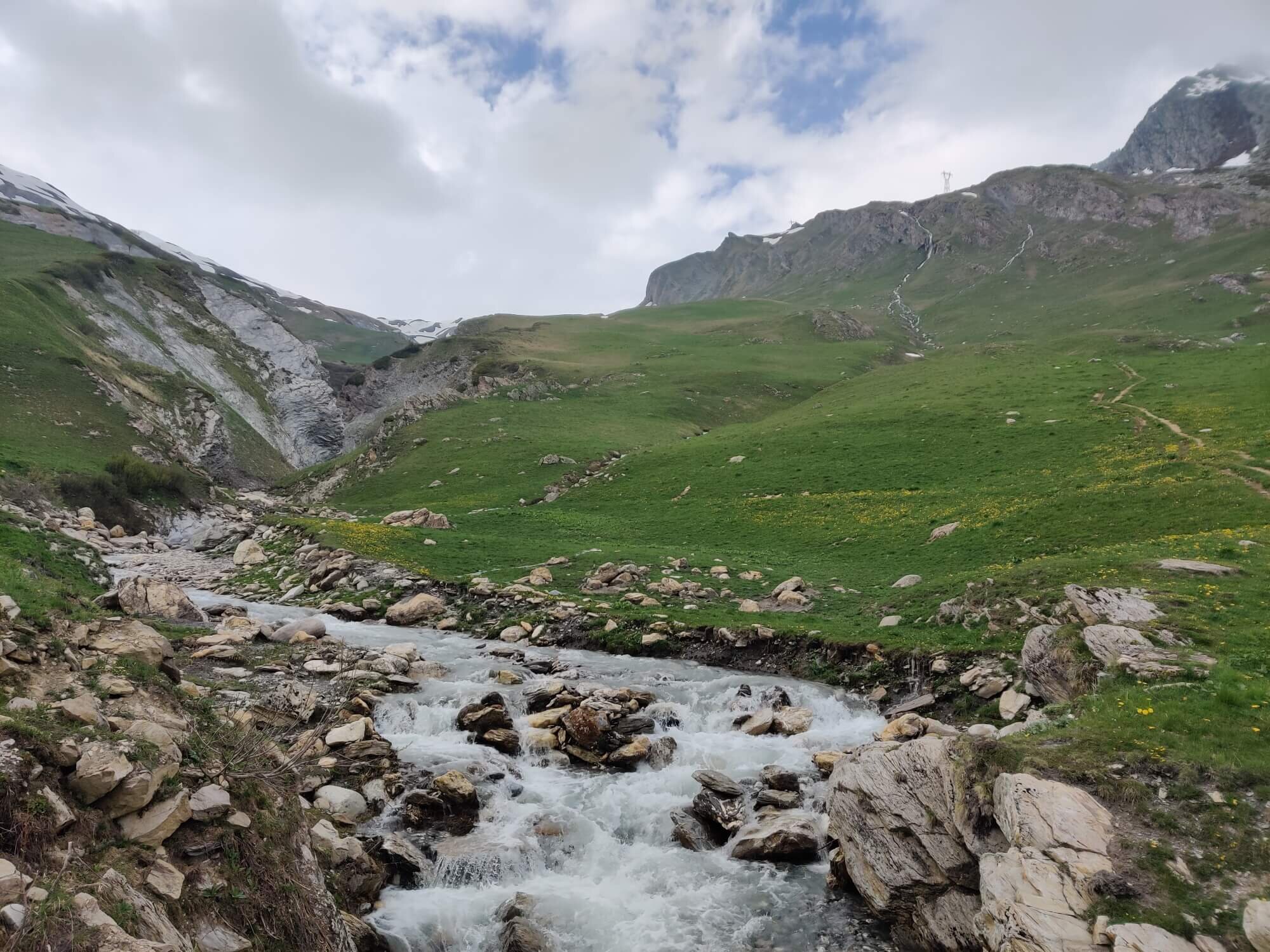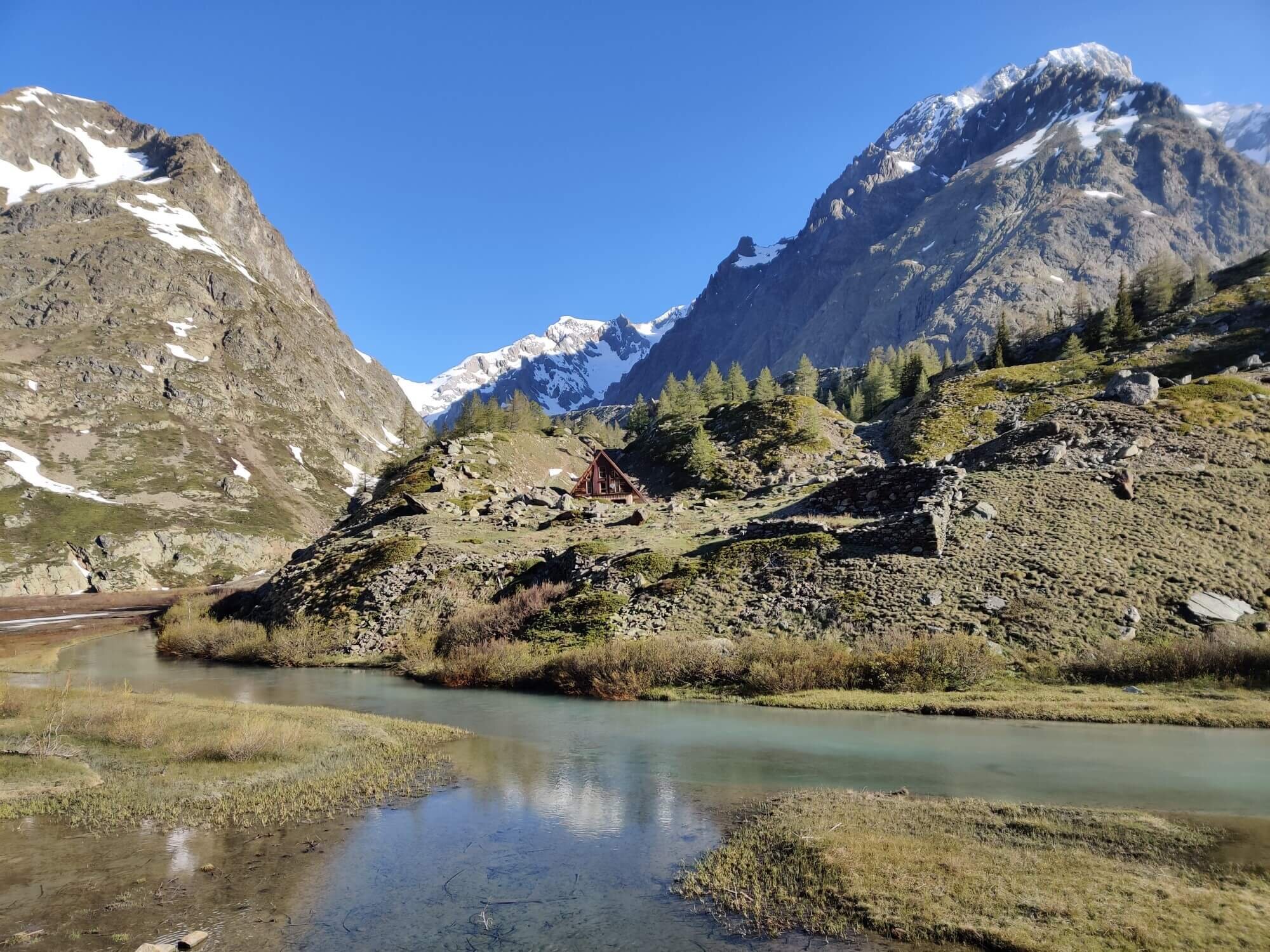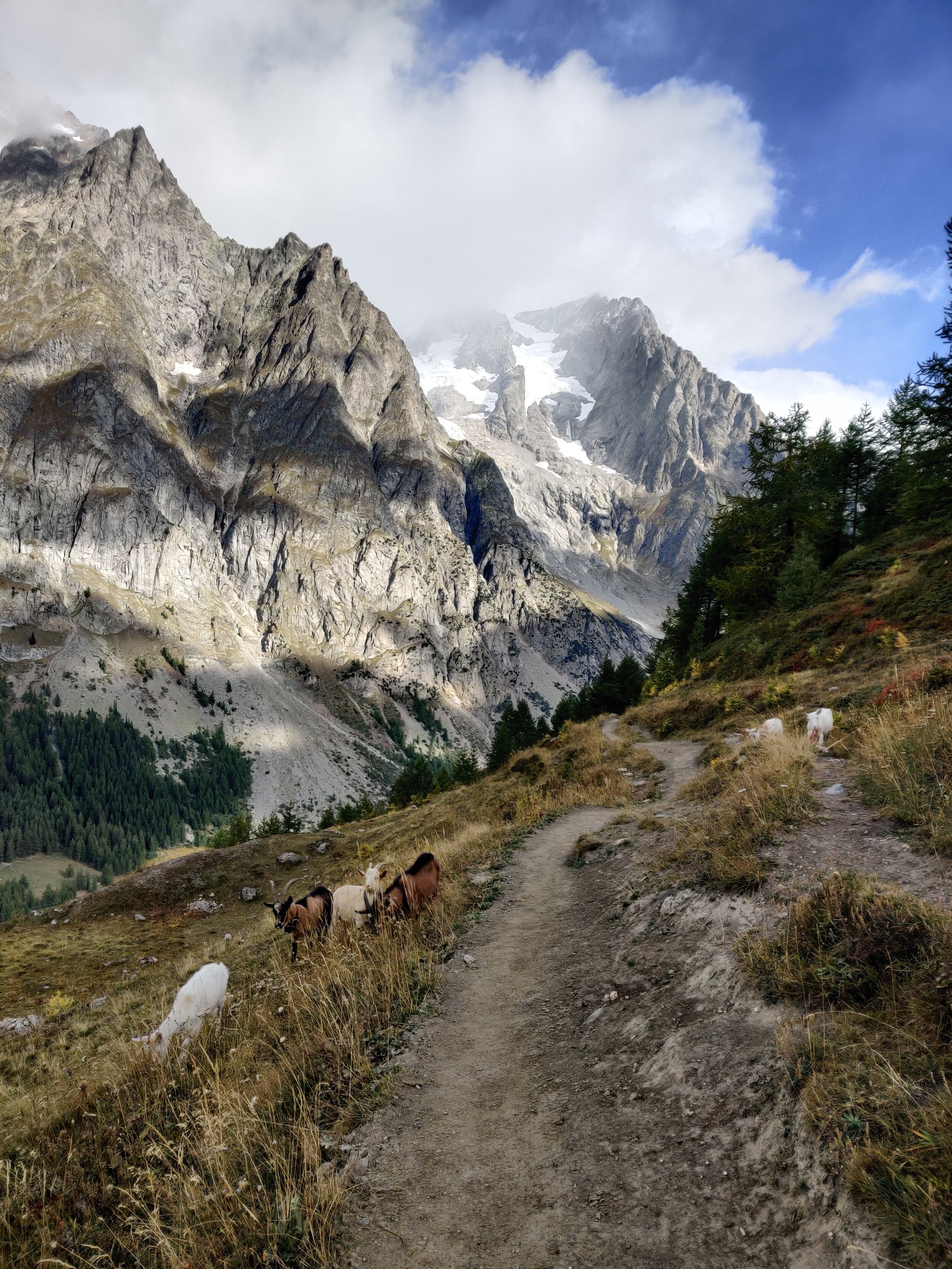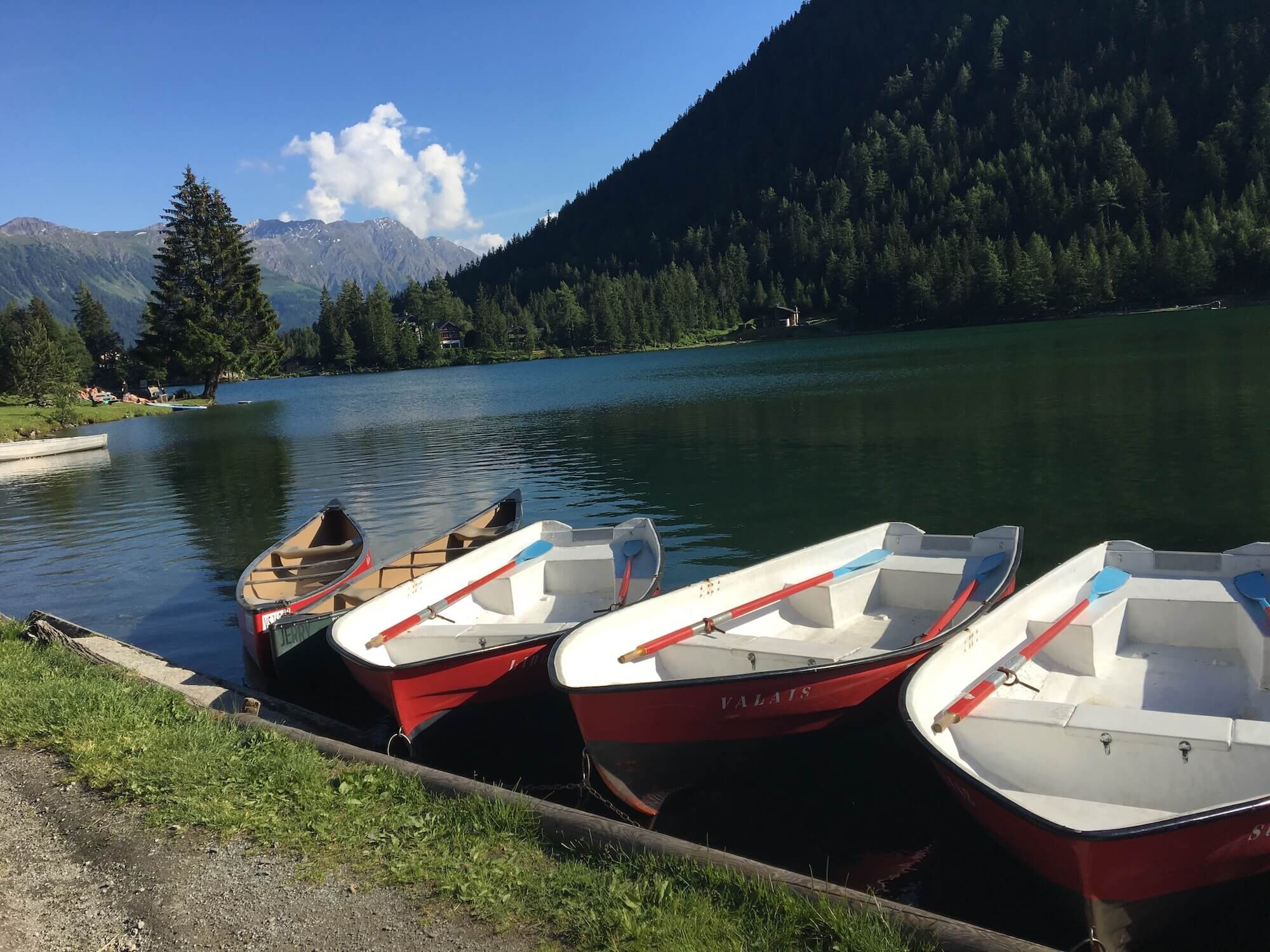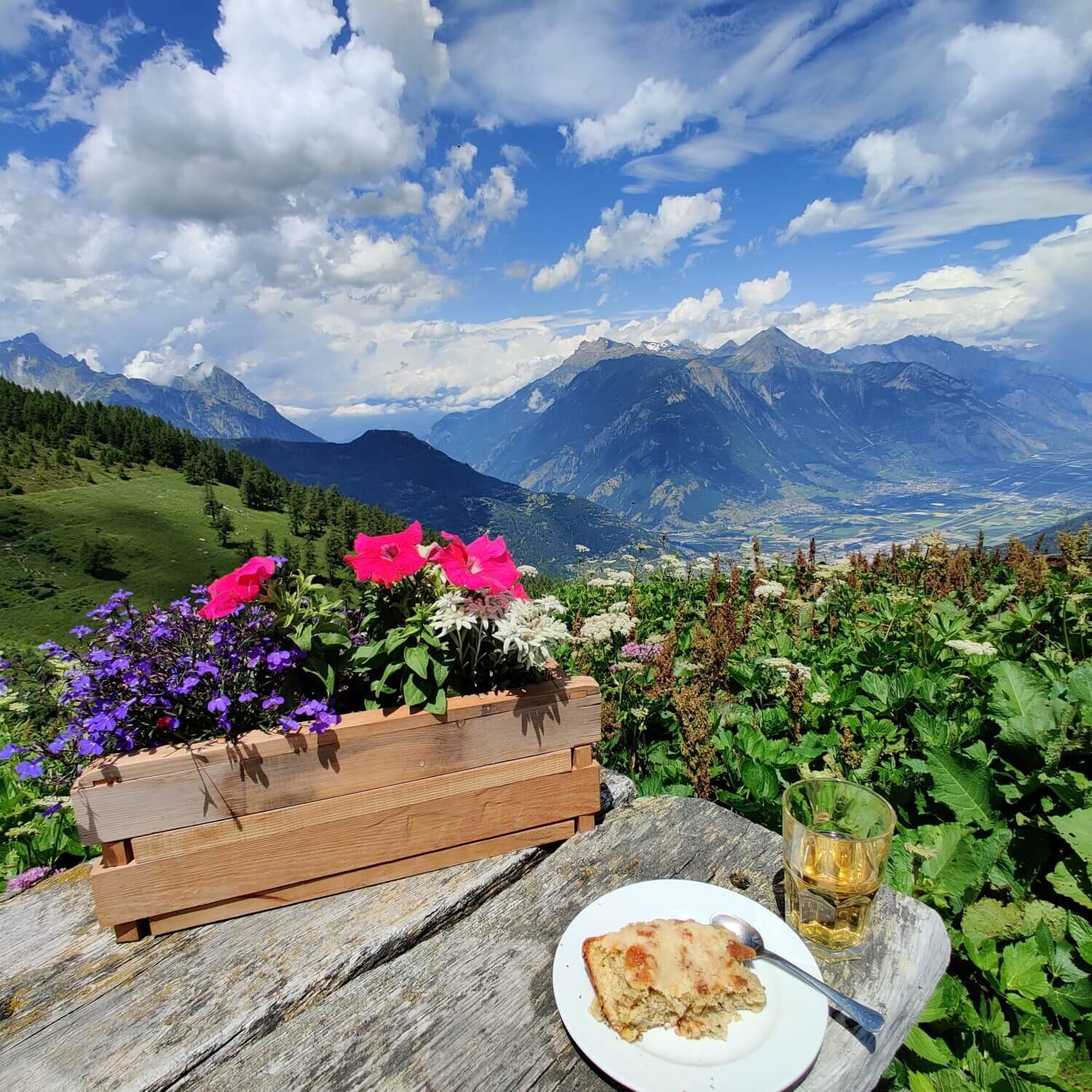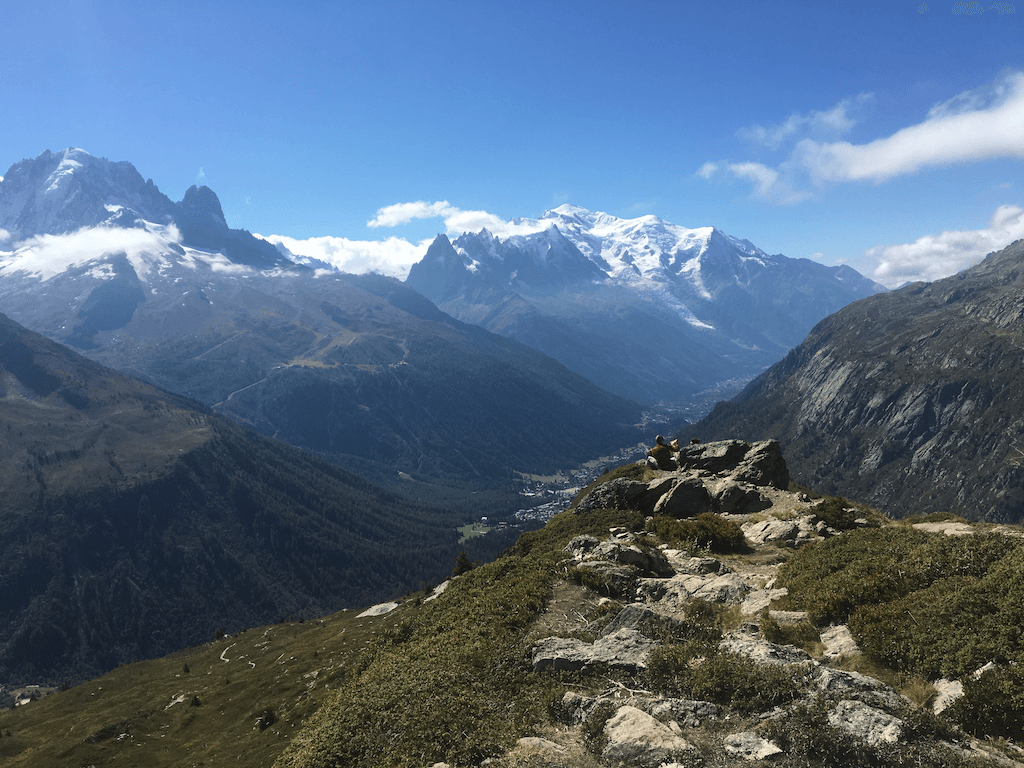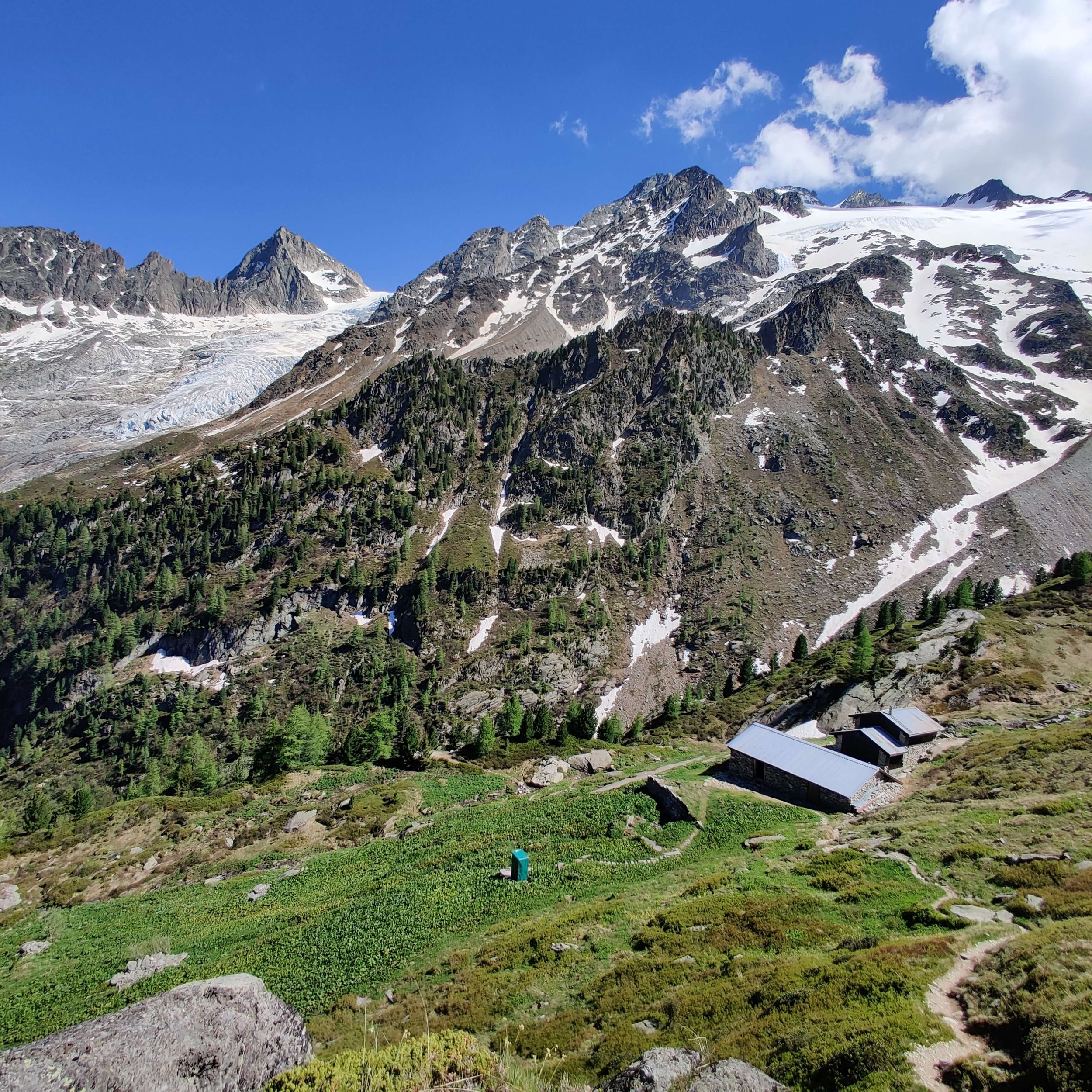Tour du Mont Blanc | Complete Guide
Everything you need to plan, book, prepare and navigate this extraordinary multi-day hike through the Alps
The Tour du Mont Blanc (known as the TMB) is the most famous multi-day hiking journey in the Alps. Mont Blanc (French), Monte Bianco (Italian), or "White Mountain," is the highest peak in the European Alps, standing at an imposing 4,810 meters (15,781 feet). The trail follows well-maintained paths through France, Italy, and Switzerland, leading hikers around the Mont Blanc massif. Each side offers contrasting landscapes of unparalleled beauty, and the host countries warmly welcome hikers from around the world with their renowned alpine hospitality. It's no surprise that the Tour du Mont Blanc is the most popular hut-to-hut hiking trail in Europe.
KEY TRAIL STATS FOR “CLASSIC” ROUTE
Countries: France, Italy and Switzerland
Number of days: 10 (at Steady pace)
Distance: 166km / 103mi
Elevation gain: 10,000m / 32,700 ft
Highest point: 2,526m / 8,287 ft
Number of mountain passes/peaks crossed: 10
Season: June - September
Difficulty: Moderate
Traffic: High
Official start/end location: Les Houches
Tour du Mont Blanc: High level map from our planning app showing the trail around the massif which is located at the intersection between the French, Italian and Swiss borders. The city of Geneva to the West and Turin to the South.
ACCOMMODATION OPTIONS ALONG THE TRAILS
Rifugio Elisabetta
There are 110+ accommodation locations along the Tour du Mont Blanc, ranging from mountain huts, known as rifugios (Italian), refuges (German), gites / cabane (French), to guest houses, hotels and B&Bs. Due to its popularity, many of the mountain huts get booked up for the summer hiking season.
Properties typically start accepting bookings between September and January prior to the hiking season. Some of the popular locations will book up quickly for peak dates (July and August), while others will have availability right through the hiking season. Click here to see live availability of ~50 mountain huts.
Availability is constantly updating with people changing and cancelling their beds/rooms daily. Therefore, it is possible to secure beds at locations currently showing no availability by setting up alerts in our planning app when beds at your target location become available on your preferred date. For those early planners, you can also set up alerts for when accommodations first start accepting bookings for the next hiking season!
CLASSIC TRAIL HIGHLIGHTS
What is the Distance of the TOUR DU MONT BLANC?
Lac Blanc is located on a popular alternative route with refuge and permitted bivouac locations nearby
The “classic / main” Tour du Mont Blanc route is 166km / 103mi, with ~10,000m / 32,700 ft in elevation gain. There are alternative or variant routes that change the distance and elevation, either to take a more direct route, reach a specific highlight or stay at accommodation off the classic route.
Depending on your route, hiking speed, and including public transport it can take anywhere from 6 to 12 days to complete the journey around Mont Blanc. See sample itineraries here.
Please note that the 166km (103mi) stated above for the main route distance has been determined using detailed GPS tracking and trail measurement software. This may be different to guide books (168km | 104mi), that disclose their distance as an estimate only, and UTMB race (170km | 106mi), that has sections on the road away from the main TMB trail. Learn more about our accurate trail data.
We include 20+ popular alternative routes in our Trip Planning app, including Col de Tricot, Col des Fours, Col Sapin, Fenetre D’Arpette, Les Grands, Glacier du Tour and Lac Blanc Trail.
These alternative routes include additional highlights, avoiding challenging sections of trail or skipping highlights on the main trail by going more direct. For a full summary of the main and alternate routes (including images, trail stats and descriptions), read the detailed blog posts.
HOW LONG DOES IT TAKE TO HIKE THE TOUR DU MONT BLANC?
It can take between 6 and 12 days to complete the Tour du Mont Blanc. It depends on which route you decide to take, your hiking speed, the desired number of hiking hours per day and whether you will use transport to skip ahead on the trail.
Some hikers are up at the crack of dawn and will arrive at their accommodation in time for dinner, having hiked for 8+ hours. Whereas others prefer a slow start, long lunch at mountain hut and an early arrival at their location, having hiked 4-5 hours.
Check out our time estimate calculator to see how long it will take you to hike the Tour du Mont Blanc.
Hiking Style: Hikers of all fitness, experience and mindset complete the trail each year. Choose an itinerary that gives you the right mix of physical challenge and mindfulness.
Where Does the tour du mont blanc start and end?
The Tour du Mont Blanc is a circumnavigation of the Mont Blanc massif, it does not summit any of the peaks on the massif. It passes through numerous towns and villages which allows hikers to select the different start/end location. The most popular start/end locations are:
LES HOUCHES, FRANCE:
This is the most popular start location of the Tour du Mont Blanc and even has an arch to signify the trail head. It is preferred due to its accessibility to Geneva airport (93km / 58mi) and being the location where the trail crosses the Chamonix valley. Those hiking in a counter-clockwise hiking direction also have the option of catching the cable car to the Bellevue plateau which skips the intial 667m / 2,188ft climb to Col Voza, leaving mostly descending trail for their first day.
Choose Les Houches trailhead as your start/end in our planning app for accurate daily hiking stats.
Les Houches: The unofficial start line for the Tour du Mont Blanc
Chamonix (Plan Praz), France:
One of Europe’s adventure capitals, offering world-class hiking, biking, climbing and paragliding opportunities in the summertime. With over 9,000 permanent residents, it has everything you need to prepare or resupply for your hike. There are several supermarkets, many outdoor stores and facilities. Many people choose to spend an extra night (or two!) in Chamonix either before their hiking adventure to acclimatise or after to enjoy the amenities of the valley - especially the spas!
Please Note: The Tour du Mont Blanc does not pass through Chamonix. It follows a trail about 1,000m / 3,280ft above the valley, which can be easily reached with the Plan Praz Gondola.
Choose Chamonix as your start/end in our planning app for accurate daily hiking stats and transport to reach the trail via gondola.
COURMAYEUR, ITALY
Courmayeur is the Italian gateway town to Monte Bianco, for hiking, skiing and climbing. It's a smaller version of Chamonix but still has plenty of accommodation, shops, services and fine Italian food for those kicking off their Tour du Mont Blanc adventure here. The nearest International airports are Geneva (116km), Turin (151km) and Milan Malpensa (213km). Although Geneva is still closest, you’ll need to pass through the Mont Blanc tunnel to reach Courmayeur which increases the transfer cost and duration of trip.
Given most hikers start from Les Houches / Chamonix on the weekend, if you start at Courmayeur on the weekend too, you’ll likely be between the two weekend waves coming from the Chamonix valley and have less hikers on the trail with you.
Courmayeur: The best place in Italy to kick off your Tour du Mont Blanc.
Choose Courmayeur as your start/end in our planning app for accurate daily hiking stats and transport options within the region.
CHAMPEX-LAC, SWITZERLAND
If you would like to start your tour in Switzerland, the best location is Champex-Lac. It is accessible by Switzerlands famous (but expensive) public transport system from Geneva airport (3h), Zurich (5h) and Basel (5h). It is a small village with a supermarket, ATM, outdoor store and multiple restaurants, situated on a beautiful alpine lake.
An added benefit of starting your Tour du Mont Blanc from Champex Lac is that the main trail is mostly descending over the first ~5km / 3.1mi in both directions, unlike the other start locations.
Champex-Lac: You can hire a row boat, fish or have a dip if the water isn’t too cold.
Choose Champex Lac as your start/end in our planning app for accurate daily hiking stats and transport options within the region.
ready to start planning your tour du mont blanc hike?
which direction to Hike the TOUR DU MONT BLANC?
The Tour du Mont Blanc (TMB) can be hiked clockwise or counter-clockwise. Key factors to consider include:
Use our trip planning app to easily add transport to your itinerary, including gondola, bus and trains.
Warming Up: Starting from Les Houches is easier counter-clockwise, with a gradual climb to Col de Voza. From Chamonix (Plan Praz), a clockwise start is gentler. For Courmayeur and Champex Lac, there’s little difference, although starting clockwise from Champex Lac includes a downhill boost.
Using Transport: The counter-clockwise direction allows skipping more elevation gain via transport (15%). For minimizing descents, clockwise is preferable.
Crowd Avoidance: Most hikers (90%) go counter-clockwise. To avoid crowds, starting clockwise provides clearer paths and more solitary stretches.
Longest Accommodation Gap: The longest stretch without accommodation is between La Fouly and Champex Lac (15 km). This section is easier with less elevation gain when hiked counter-clockwise.
Best Views: Scenic highlights depend on direction:
Grand Balcon Sud: Best viewed counter-clockwise.
Fenetre d’Arpette and Grand Col Ferret: Best in a clockwise direction for panoramic views of Trient Glacier and Val Ferret.
Select your direction based on these preferences and personal needs for an optimal hiking experience.
What are the tour du mont blanc Alternative Route Options?
There are many alternative routes to include additional highlights, avoid challenging sections of trail or skip highlights on the main trail by going more direct. Details of these alternate routes (and more) are available within our planning app.
The most popular alternate routes along the Tour du Mont Blanc, include:
Lac Blanc
This variant allows you to look deeper into Mer de Glace across the valley and features the popular picturesque lake.
Fenetre d’Arpette
This variant is quite challenging due to a long boulder field crossing and a steep eroded mountain pass on the Champex side. However, it offers breathtaking views of the Trient Glacier.
Col Sapin
This variant climbs higher than the main trail onto a rounded ridge line allowing you to looker deeper into the massif.
Col du Tricot
This variant brings you closer to the Mont Blanc massif, includes a suspension bridge crossing, and features unparalleled views of the Miage glacier.
Le Tour Glacier
This variant is the only opportunity to see a glacier up close on the Mont Blanc massif while keeping the Tour du Mont Blanc trail in sight.
Refuge Robert Blanc
This variant is a much more challenging route, particuarly the traverse of the massif between Robert Blanc and Col de la Seigne. It has narrow balcony trail, cable assisted sections and water crossings. Those who take this trail are rewarded with wonderful views down Vallee des Glaciers.
Mont Fortin
This variant includes a section of balcony trial near Col de la Seigne, crossing of a high alpine plateau and steep ridgeline traverse between Mont Fortin and Alpe Superieure. On a clear day, it offers a wonderful view across Val Veny to the massif above Rifugio Elisabetta in the valley below.
Refuge Les Grands
This variant offers a great opportunity to enjoy the Trient Glacier and includes a stone staircase. It is a great option for those who wish to skip Trient / Le Peuty.
Col Cornu
This variant follows a high route on the Aiguilles Rouges and leads you past some alpine lakes on the other side of the ridge.
How does the tour du mont blanc compare to other legendary hikes in the area?
The Tour du Mont Blanc is one of the easier legendary hiking trails in the Alps due to the well-maintained hiking and mountain trails (no alpine trails), frequent accommodation options spaced along the trail, affordable baggage transfer services and mountain passes staying below 2,650m / 8,366ft. For these reasons, it is also the most popular multi-day hike in the Alps. There are many other hikers (and tour groups) that choose this trail and therefore make sure to book your accommodation well ahead of time to secure your preferred locations and dates.
For those looking for a multi-day trail that is more challenging and remote with less crowds, you should consider the Walker’s Haute Route or Tour of Monte Rosa. See below for a comparison between other popular multi-day hikes in the Alps.
WHEN DOES ACCOMMODATION START TO BOOK UP?
Properties typically start accepting bookings between September and January prior to the hiking season. Some of the popular locations will book up quickly for peak dates (July and August), while others will have availability right through the hiking season. If you’ve started planning your TMB and find that all the locations you want are booked for your dates, we can help!
Check out our 11-day “TMB Anytime” itinerary, which allows you to stay in villages and use transport to access accommodation. Whether you are booking in November, February or July, this itinerary will allow you to keep your TMB dream alive!
Read our “Booking Tips and Tricks” blog that outlines ways to tweak your current itinerary to find available accommodation.
Need help to find accommodation with availability? Our Expert Access package gives you access to a trail expert who will prepare an itinerary that has accommodation availability for your preferred dates.
The “TMB Anytime” itinerary utilises our transport network for hikers to reach nearby villages to find available accommodation
Is it possible to CAMP along the Tour du Mont Blanc?
Yes - it is possible to bivouac or stay in campgrounds in villages along the Tour du Mont Blanc.
There are very strict rules put in place by the national and local governments for those that wish to bivouac. Due to the prevalence of private land (high alpine farms/ski resorts), protected reserves and inhospitable slopes for sleeping, there are only a handful of locations along the trail that abide by these guidelines and are suitable.
In terms of campgrounds, the type and quality of facilities differ, but in general there are hot showers, kiosk/cafe or restaurant and wifi. The average cost for 1 person in a small tent is 10-25 EUR per night. Unfortunately some villages (and key locations) don’t have campgrounds so you’ll either need to divert off the trail for a few km/mi or take advantage of low cost dormitory or hotel room options available for those nights.
Bivouac location next to Glacier du Tour on the alternative route.
Find 18 permitted bivouac locations and 17 campgrounds in our trip planning app for the Tour du Mont Blanc.
HOW MUCH DOES IT COST TO HIKE THE tour du mont blanc?
One of the primary questions first-timers have about hiking in the Alps is how much it will cost. There are so many elements to calculate - accommodation, transportation, food etc - that can make it difficult to determine whether a bucket-list trip to the Alps is possible.
Using actual costs as of January 2024, once you arrive in Geneva Airport, you can hike the Tour du Mont Blanc from:
Camping: 600 EUR per person
Solo in Dormitory: 900 EUR per person
Double in Private Rooms (where possible): 1,100 EUR per person
This is based on a standard 10 day route and what you can expect by planning your trip using our self-guided products. It includes transfers to/from the trail, accommodation in huts/hotels and eating delicious 3-course meals of local delights, as you self-guide your way across one of the legendary trails of the world.
For those looking to join a tour group rather than self-guide, the cost is typically upwards of 1,500 EUR per person.
For a full break-down of the cost calculation, see the detailed blog post.
